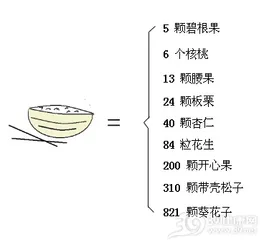Although nuts are scary in calories, they can actually lose weight
During the New Year, all kinds of nut and snack bags come in. How can you refuse the ones you like? However, as a full-out foodie, some people have a dream of losing weight. Seeing the calories of nuts, the food had to let go of them.
Do nuts really get fat if they eat high calories?
Are the calories of nuts really that scary? Xiaobian compares the calories of some frequently eaten nuts with the calories of a bowl of rice, and everyone will know.

The above data are calculated by editors who went to supermarkets to weigh nuts on site, and are for reference only. The specific investigation process can be viewed by clicking on "Nuts Calories".
Well, 6 walnuts are equivalent to a bowl of rice. At first glance, the calories are really scary. The fat content of nuts seems worrying, with the fat content of ordinary nuts ranging from 40% to 80%. However, if you judge that nuts will make you fat based on their high calories, you are wrong!
Reuters once reported that a new study in the United States proved that nuts can help you lose weight! Scientists analyzed the eating habits of 803 participants and found that those who ate the most tree nuts such as pine nuts, almonds, and walnuts had a 37% to 46% lower obesity rate than those who ate the least nuts.
Some people have said that nuts have high calories and fat, but can they lose weight? This is simply unreasonable! Here, I want to defend the nuts. Nuts are indeed high in fat, but the fat contained in nuts is unsaturated fatty acids. The intake of unsaturated fatty acids and high-protein foods in nuts will increase the caloric effect of food to a certain extent, resulting in the consumption of a large amount of energy. In addition, nuts are rich in dietary fiber. Dietary fiber is a polysaccharide that is not easily absorbed by the gastrointestinal tract, has low calories and a strong feeling of satiety. So when eating nuts, we don't have to eat a lot to feel full. Nuts also contain a "weight loss weapon"-dietary fiber. Dietary fiber can promote gastrointestinal peristalsis, speed up the passage of food through the gastrointestinal tract, and reduce absorption. It can also soften stools and improve constipation, which is of great significance for weight loss. Other studies have pointed out that nuts also contain many active substances, such as polyphenols, catechins, epicatechins, etc. These substances can promote metabolism and have certain weight loss effects.
So, don't blame nuts, let alone blame nuts for the obesity you have caused by eating Hussein!

Nuts can lose weight, can you eat them willfully?
However, although nuts have certain effects on weight loss, this does not mean that nuts can be eaten willfully. Almost any food that can be put into your mouth will bring calories to a person. If you eat it too much, even if the food has weight loss effects, it will not be able to make you lose weight. Even apples, which we often talk about as a weight-loss expert, will make you fat if you eat too much, let alone nuts?
As a senior foodie, in order to eat more nuts, Xiaobian took great pains to find a way for everyone to eat nuts without getting fat:
1. Find a nut mate
Eat nuts while watching the Spring Festival Gala on the New Year after dinner, and you will eat too much before you realize it. Studies have shown that if nuts are added to a meal and eaten with starchy foods, they can make a feeling of fullness last longer. Therefore, nuts should not be eaten after meals, but should be eaten before or with the main meal.
2. Choose "bad" nuts
At the beginning of life, people are inherently lazy, and we can grab and eat whatever we can easily put into our mouths. However, if you have to work hard to peel the shell to eat it, people will be too lazy to eat. The eating speed will be much slower, and the amount of food will naturally be less. In order to avoid being unable to control yourself and greedy for nuts, you can choose some nuts that are difficult to peel, such as pumpkin seeds, pine nuts, shelled walnuts, etc.
3. Avoid fried nuts
Although fried peanuts, fried almonds, etc. taste good, they have more fat, higher calories, and B vitamins are destroyed. In order to eat healthily and safely, it is better for everyone to detour nuts processed by roasting, frying, boiling, stewing and other methods.
It's New Year's Eve, if you don't want to spoil everyone's appetite for food, you can eat and take responsibility for it when you get fat. Xiaobian will go get the nut gift bag first.
